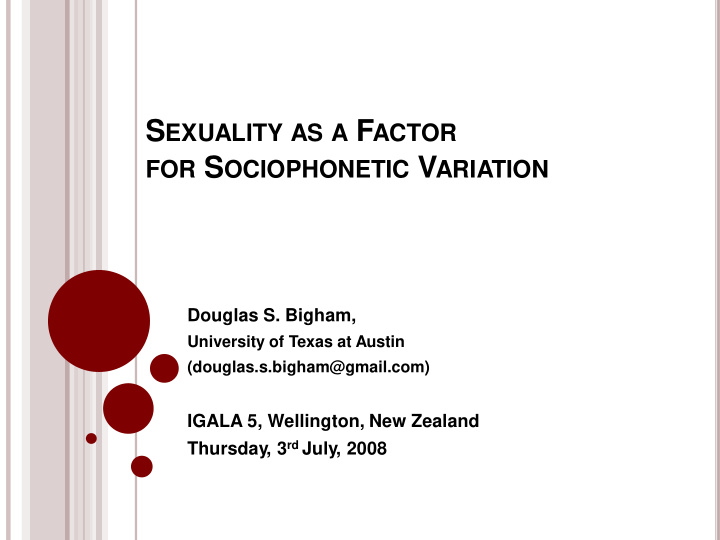



S EXUALITY AS A F ACTOR FOR S OCIOPHONETIC V ARIATION Douglas S. Bigham, University of Texas at Austin (douglas.s.bigham@gmail.com) IGALA 5, Wellington, New Zealand Thursday, 3 rd July, 2008
A L ITTLE B ACKGROUND ... D IALECT C ONTACT AMONG U NIVERSITY S TUDENTS Dialect Contact What happens when speakers of two different dialects interact with each other? Trudgill, 1986; 2004 University Students Close, persistent, intimate contact Population is transient and dynamic, but “anchored” Emerging Adulthood Period between High School and “true” Adulthood Roughly 18-26 age range Marked by exploration, self-discovery, and change J. Arnett, 2001
D IALECT G EOGRAPHY FOR THIS S TUDY : T HE N ORTHERN C ITIES S HIFT (NCS) IN I LLINOIS
S PEAKER C ATEGORIZATION : S PEAKER S EX Female vowel space is, on average, larger than male vowel space Anatomical differences cannot account for the kinds or magnitudes of difference (Diehl, et al., 1996) Men and women participate differently in lg. variation women lead change; women are more conservative lg. users women adhere more to overtly proscribed norms (Labov, 2001) women prefer community-level, wide-solidarity forms... ...while men prefer group-level, close-solidarity forms (Milroy & Gordon, 2003; see also Coates, 2003) Problems... Implicit heterosexuality / heteronormativity Begging the “why?” question…
S PEAKER C ATEGORIZATION : S PEAKER S EXUALITY Kulick (2000): “search for gay and lesbian language” Discourse-based Approaches What do “gays” talk about & how do they talk about it? Leap, 1996; Barrett, 1999; Cameron & Kulick, 2003 Perception-based Approaches What does a speaker do that makes him “sound gay”? Gaudio, 1994; Levon, 2007; Munson & Babel, 2007 Sexuality as a factor in sociolinguistics Speaker sexuality as a factor for categorization has largely been ignored.
S PEAKER C ATEGORIZATION : S PEAKER “G ENDER ” Sex+Sexuality = GENDER SEX→ biologically biologically n/a SEXUALITY ↓ male female “man” “woman” normative --- “gay” “lesbian” non-normative --- “trans” n/a --- --- Problems... define “normative”... trans individuals...
V OWEL V ARIANTS : P RODUCTION & P ERCEPTION Vowels (using Wells‟ Key Words): TRAP raised & fronted in NCS-influenced dialects high front DRESS-like variant = Chicagoland identity LOT fronted and/or lowered in NCS-influenced dialects fronted variant = Chicagoland identity GOOSE fronted in Midlands speech, but not NCS dialects no variants are salient FOOT & KIT not undergoing NCS-related shifts (~FOOT may be fronting) completely non-salient
“S TRAIGHT ” M EN & W OMEN
“G AYS ” & “L ESBIANS ”
S UMMARY : “G ENDER ” -B ASED V ARIATION “Gays” show the most progressive linguistic variants, regardless of salience After “Gays”, “Women” show the most progressive non-salient forms , followed by “Men” Which speakers show the most progressive salient forms , however, depends on the “meaning” of a variable “Lesbians” show the least progressive / most conservative variants
E XPLAINING THE P ATTERNS : R ECONSIDERING “G ENDER ” Ta-da! But why? Why would “gays” be among the first adopters of linguistics changes and “lesbians” among the last? Reconsidering what we “know”: Women are „community - oriented‟ Men are „group - oriented‟ Can a person be both? Neither?
“G ENDER ” P ATTERNS : A T ENTATIVE E XPLANATION “Community” - level vs. “Group” -level “community” = global, society, out -group- oriented, sex… professional/public- level issues…status, power “group” = local, self, in -group- oriented, sexuality… personal/private-level issues... solidarity, affect Active vs. Passive Identity Construction Active = aware, self-constructed, oriented towards Passive = subliminal, society-constructed, oriented away Community→ active passive Group↓ “community” “community” active “group” “gay” “male” passive “group” “female” “lesbian”
T HE E XCEPTION ...
G RAND C ONCLUSION : “G ENDER ” R E -R EVISED Vanguard Speakers Actively creating “community” and “group” identities Progressive Speakers Actively creating “community” identity; passively creating “group” identity Old-guard Speakers Passively creating “community” identity; actively creating “group” identity Conservative Speakers Passively creating “community” and “group” identity
T HANK YOU ! Contact Info for References, Further Questions... job offers... Douglas S. Bigham, Ph.D. University of Texas at Austin douglas.s.bigham@gmail.com
Recommend
More recommend